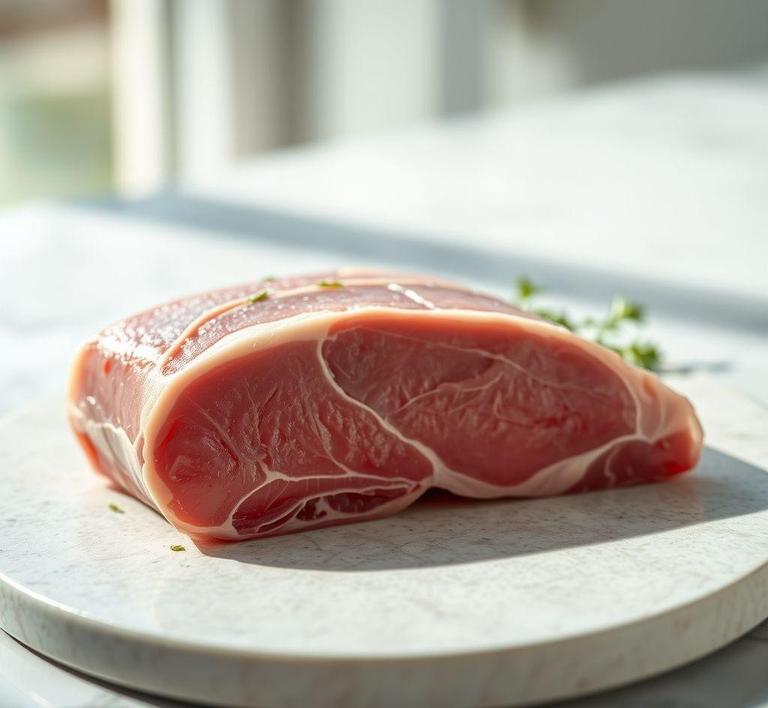If you’ve ever found yourself with uncooked pork in the freezer, only to realize you might not cook it in time, you might be wondering if it’s safe to refreeze it. Refreezing uncooked pork is actually a topic that can cause a bit of confusion, but it’s important to know the best practices to ensure safety and maintain the quality of the meat. While refreezing raw pork is possible, there are some key guidelines to follow. In this guide, we’ll dive into the dos and don’ts of refreezing uncooked pork, including how to handle it properly before freezing, the risks to consider, and how to keep your pork tasting great after it’s been frozen and refrozen.
Can You Refreeze Uncooked Pork?

When it comes to food safety, particularly with meats like pork, there’s often confusion about whether it’s safe to refreeze it after thawing. This question is especially common when it comes to uncooked pork, which is a highly perishable meat. So, can you refreeze uncooked pork? The answer, in short, is yes, but there are some important caveats to consider.
The main concern with refreezing uncooked pork (or any meat, really) revolves around food safety and quality. If pork is thawed and left at room temperature for too long, bacteria can grow, making it unsafe to refreeze. However, if the pork was thawed in the refrigerator and has not been left out for extended periods, you can safely refreeze it, though there are some nuances to understand.
The USDA states that food should be refrozen only if it has been thawed in the fridge and hasn’t reached temperatures that allow harmful bacteria to grow. This means that if you’ve thawed your uncooked pork in the fridge (at temperatures of 40°F or below), you can safely refreeze it within a few days without any risk of bacterial growth. However, if it was thawed using methods like the microwave or under cold water, refreezing is not recommended due to the rapid temperature changes which can allow bacteria to proliferate.
How To Refreeze Uncooked Pork?
Refreezing uncooked pork is straightforward as long as you follow proper guidelines to maintain both food safety and quality. Here are the key steps:
- Ensure Pork Was Thawed Properly: First and foremost, you must make sure that the pork was thawed in the refrigerator and not on the counter or in hot water. If the pork was left at room temperature for more than two hours, or one hour if the temperature is above 90°F, it is considered unsafe to refreeze.
- Pat Dry Before Refreezing: If you’ve defrosted the pork in the fridge, it’s essential to pat it dry with paper towels before refreezing. This helps remove excess moisture, which could lead to freezer burn or degradation of quality during the next freeze.
- Portion and Wrap Properly: To preserve freshness and make the refrozen pork easier to use later, it’s a good idea to divide it into portions that you’ll use at one time. Wrap the pork tightly in plastic wrap, aluminum foil, or a vacuum-seal bag to protect it from air exposure, which can lead to freezer burn.
- Label and Date: Labeling the packaging with the date of refreezing ensures that you know how long the pork has been in the freezer. Uncooked pork, when refrozen, should ideally be consumed within 4-6 months for optimal quality.
- Freeze Promptly: Once the pork is properly wrapped and portioned, place it back into the freezer as soon as possible. Don’t leave it sitting out at room temperature any longer than necessary, as this could lead to bacteria growth.
Quality Impact
While it is technically safe to refreeze uncooked pork under the right conditions, doing so can have a noticeable impact on its quality. The biggest change you’ll notice is in texture. Each time pork is frozen and thawed, the water inside its cells forms ice crystals. These ice crystals can puncture the cell walls of the meat, which leads to a loss of moisture when the meat is thawed again. As a result, refrozen pork can become drier, tougher, and less flavorful.
In terms of taste, while refreezing pork will not make it unsafe to eat, you might find that the flavor isn’t as fresh as it would have been if it had been cooked immediately after thawing. The refreezing process can cause the breakdown of some proteins and fats, leading to a slight change in taste or texture.
The packaging and handling process plays a significant role in preserving the quality of refrozen pork. If the meat is exposed to air during freezing, you may also encounter freezer burn, a condition where the meat becomes discolored and dry. This isn’t harmful to consume but can affect both the texture and flavor. To minimize freezer burn, it’s essential to wrap the pork tightly, ensuring there is no exposure to air.
Refreezing uncooked pork is certainly possible, but it’s a practice that requires caution. If the pork was thawed safely in the refrigerator and hasn’t been left at room temperature for too long, you can safely refreeze it without putting yourself at risk of foodborne illness. However, repeated freezing and thawing can have a noticeable impact on the texture, moisture, and overall quality of the pork. For the best results, it’s ideal to limit the number of times pork is frozen and thawed, and to take care in how you store it.
Is It Safe To Refreeze Uncooked Pork?
Refreezing uncooked pork can be a controversial topic among home cooks, with safety concerns at the forefront. In theory, it is possible to refreeze uncooked pork, but it comes with several critical considerations. The primary issue revolves around the temperature and handling of the meat during each freeze and thaw cycle. The first time you freeze pork, it should be done quickly and at the correct temperature to ensure that ice crystals form inside the meat without damaging its cellular structure. This is important because large ice crystals can puncture the meat’s cells, which may affect its texture and juiciness.
When you thaw pork, it’s crucial that it stays within a safe temperature range. According to the USDA, the safe zone for thawing meat is at or below 40°F (4°C), as anything warmer can promote bacterial growth. If the pork is thawed at room temperature or above 40°F, bacteria can begin multiplying, increasing the risk of foodborne illness when refrozen. Once pork has been thawed under safe conditions, you can technically refreeze it, but you should ensure that the pork has not been left out too long or exposed to temperatures above the safety threshold.
Additionally, each time pork is frozen and thawed, it undergoes some degradation in texture and flavor. While it’s safe in the sense that it doesn’t pose an immediate health risk, the quality of the meat will diminish with every cycle, resulting in a less pleasant dining experience. This quality loss is especially notable with cuts like chops or tenderloin, where the meat’s natural texture and juiciness can be compromised.
In conclusion, refreezing uncooked pork is technically possible but should be approached cautiously. For the best taste and texture, it is ideal to only thaw pork once before cooking. If you do need to refreeze, make sure to follow safe thawing and freezing practices, ensuring the meat stays below safe temperatures and is handled properly.
Signs That Uncooked Pork Should Not Be Refrozen
While refreezing uncooked pork might not be inherently dangerous, there are signs you can look for that indicate the pork should not be refrozen under any circumstance. These signs generally relate to how the meat has been handled during thawing, how long it has been left at unsafe temperatures, or the visible quality of the pork itself.
-
Off Smell or Sour Odor
One of the most noticeable signs that uncooked pork is unsafe to refreeze is a sour or off smell. Fresh pork should have a clean, neutral scent. If it smells sour, rancid, or like ammonia, it’s a clear indication that bacteria has begun to multiply, and refreezing would not make it safe to eat. The smell can also indicate that the pork has spoiled, which cannot be reversed by freezing or refreezing.
-
Slimy or Sticky Texture
If the pork feels unusually slimy or sticky to the touch, this can be a sign of bacterial growth, particularly if the meat was not stored properly after thawing. The texture should be firm and slightly moist, but not slick or tacky. If you notice this, it is best to discard the pork rather than attempt to refreeze it.
-
Discoloration or Dryness
Uncooked pork should be a pale pinkish color, with a slight marbling of fat. If the pork has developed an off-putting grayish or brownish tint, it could be a sign of spoilage or improper storage. Additionally, if you see large areas of freezer burn (ice crystals or dryness on the meat), these areas might be safe to discard. While freezer-burned pork can be technically safe to eat, it will have a dry, unpleasant texture when cooked, which significantly impacts its flavor.
-
Extended Time in the Danger Zone
If the pork has been sitting at room temperature for more than two hours (or one hour if the ambient temperature is 90°F or higher), it falls into the "danger zone" for bacterial growth. Refreezing pork that has been left out too long could lead to foodborne illnesses. Even if the pork has been refrozen, the bacteria that multiplied during the unsafe thawing process could still cause health risks.
-
Unusual Packaging or Exposure to Air
The way the pork is packaged can also offer clues about whether it’s safe to refreeze. If the pork has been improperly sealed, allowing air to come into contact with it, the pork may have dried out, leading to freezer burn. Refreezing pork that has been exposed to air for a prolonged period will not only affect the texture but can also result in the meat being unsafe to eat.
Common Refreezing Mistakes
Refreezing meat is not as simple as just throwing it back into the freezer. Many common mistakes can be made during this process, which can affect both the safety and the quality of the pork. Understanding these errors is essential for keeping both your health and your pork chops intact.
-
Thawing Pork at Room Temperature
One of the most frequent mistakes people make is thawing pork at room temperature, which allows the surface of the meat to reach temperatures that encourage bacterial growth. The safe method for thawing pork is to place it in the refrigerator, where the temperature remains consistently at or below 40°F. If you thaw it on the counter, bacteria can proliferate rapidly.
-
Refreezing Pork That Has Been Left Out Too Long
As mentioned earlier, leaving pork out for more than two hours at room temperature (or one hour in hot conditions) is a mistake that could put you at risk of foodborne illness. Even if you plan to refreeze it, once the meat has been in the danger zone for too long, bacteria will have had a chance to multiply and cause spoilage. You should never attempt to refreeze meat that has been left out too long.
-
Freezing Pork in an Unsealed Package
If pork is not securely packaged before freezing, it can suffer from freezer burn, resulting in loss of flavor, texture, and nutrients. Many people make the mistake of freezing pork in plastic wrap or foil without sealing it in an airtight container or freezer bag. A good practice is to remove as much air as possible and seal the package tightly to avoid freezer burn.
-
Thawing and Refreezing Multiple Times
Refreezing pork multiple times is a common mistake that can drastically affect the meat’s texture and flavor. Each cycle of freezing and thawing breaks down the muscle fibers in the pork, making it tougher and less flavorful. While it’s safe to refreeze once, the more times you subject the pork to this process, the worse it will be in terms of taste and texture.
Tips And Tricks
When refreezing uncooked pork, there are a few best practices that can help you avoid potential pitfalls and ensure the pork is safe to eat while maintaining the best possible quality.
-
Freeze Pork in Smaller Portions
One of the best tips is to freeze pork in smaller, meal-sized portions. This not only helps you avoid thawing more meat than you need but also allows you to refreeze only the parts that remain unused. Smaller portions freeze more quickly and evenly, preserving the meat’s quality.
-
Use Vacuum Sealing
If you plan to freeze pork for later use, using a vacuum sealer is a game-changer. Vacuum sealing removes the air from the packaging, which can help prevent freezer burn and extend the shelf life of your meat. It also helps preserve the pork’s texture, so it’s not as prone to freezer damage when refrozen.
-
Label and Date Your Packages
Always label your packages with the date they were frozen, and use the oldest portions first. This helps you keep track of how long the pork has been stored and ensures that you use it within the safe time frame for refreezing. Freshly frozen pork will maintain its quality for 4 to 6 months, but over time, even the best frozen pork will lose flavor and texture.
-
Thaw Properly
Never thaw pork at room temperature. Instead, place it in the refrigerator or thaw it using the microwave if you plan to cook it right away. For optimal safety and quality, defrost pork in the fridge for 24 hours or use the "cold water method" if you’re in a rush.
-
Cook Before Refreezing
For optimal safety and quality, consider cooking the pork before refreezing. This removes the risk of bacterial growth during thawing, and cooked pork tends to hold up better after being frozen a second time. Make sure to cool the cooked pork to room temperature before refreezing.
Conclusion
Refreezing uncooked pork is a delicate balance between safety and quality. While it is technically safe to refreeze uncooked pork if proper guidelines are followed, it comes with inherent risks related to texture, flavor, and potential bacterial contamination. Signs of spoilage, such as foul smells or sliminess, should never be ignored, as they indicate that the pork is no longer safe to eat. Common mistakes like thawing at room temperature or improperly packaging the pork can compound these risks.
By following best practices like portioning the pork into smaller pieces, using airtight packaging, and thawing it safely, you can minimize the negative impacts of refreezing and ensure the best possible outcome when cooking. Ultimately, the key to safe and tasty pork lies in proper handling, correct freezing techniques, and minimizing the number of times the meat is frozen and thawed.


